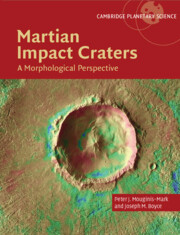
-
Select format
-
- Publisher:
- Cambridge University Press
- Publication date:
- 09 October 2025
- 30 October 2025
- ISBN:
- 9781316651162
- 9781107154919
- Dimensions:
- (280 x 216 mm)
- Weight & Pages:
- 0.74kg, 176 Pages
- Dimensions:
- Weight & Pages:
You may already have access via personal or institutional login
Book description
Our exploration of Mars has revealed a world as fascinating as Earth, with a changing climate, giant volcanoes, former oceans, polar ice caps, and numerous impact craters. This book provides a comprehensive summary of the morphology and distribution of meteorite craters on Mars, and the wealth of information these can provide on the crustal structure, surface geology, climate and evolution of the planet. The chapters present highly illustrated case studies of landforms associated with impact craters to highlight their morphological diversity, using high-resolution images and topographic data to compare these features with those on other bodies in the Solar System. Including research questions to inspire future work, this book will be valuable for researchers and graduate students interested in impact craters (both terrestrial and extra-terrestrial) and Mars geology, as well as planetary geologists, planetary climatologists and astrobiologists.
Contents
Metrics
Full text views
Full text views help Loading metrics...
Loading metrics...
* Views captured on Cambridge Core between #date#. This data will be updated every 24 hours.
Usage data cannot currently be displayed.
Accessibility standard: Missing or limited accessibility features
Why this information is here
This section outlines the accessibility features of this content - including support for screen readers, full keyboard navigation and high-contrast display options. This may not be relevant for you.
Accessibility Information
The PDF of this book is known to have missing or limited accessibility features. We may be reviewing its accessibility for future improvement, but final compliance is not yet assured and may be subject to legal exceptions. If you have any questions, please contact accessibility@cambridge.org.
Content Navigation
Table of contents navigation
Allows you to navigate directly to chapters, sections, or non‐text items through a linked table of contents, reducing the need for extensive scrolling.
Index navigation
Provides an interactive index, letting you go straight to where a term or subject appears in the text without manual searching.
Reading Order and Textual Equivalents
Single logical reading order
You will encounter all content (including footnotes, captions, etc.) in a clear, sequential flow, making it easier to follow with assistive tools like screen readers.
Structural and Technical Features
ARIA roles provided
You gain clarity from ARIA (Accessible Rich Internet Applications) roles and attributes, as they help assistive technologies interpret how each part of the content functions.

